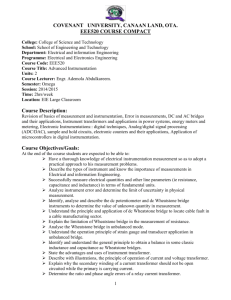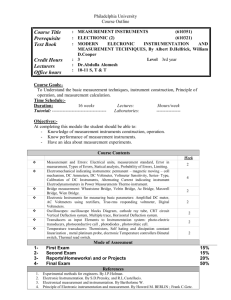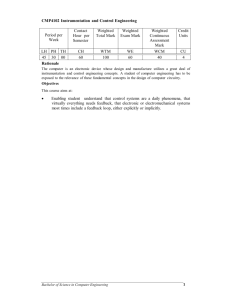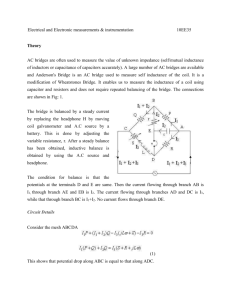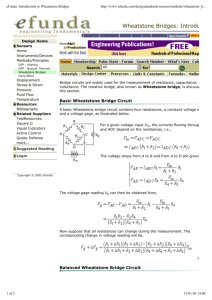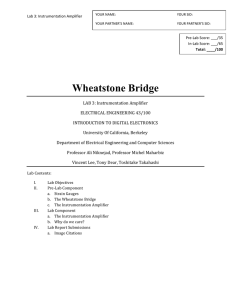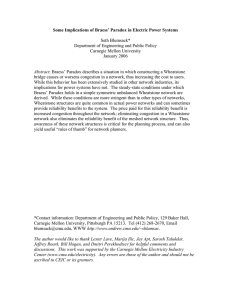Course Description - Department of LD
advertisement
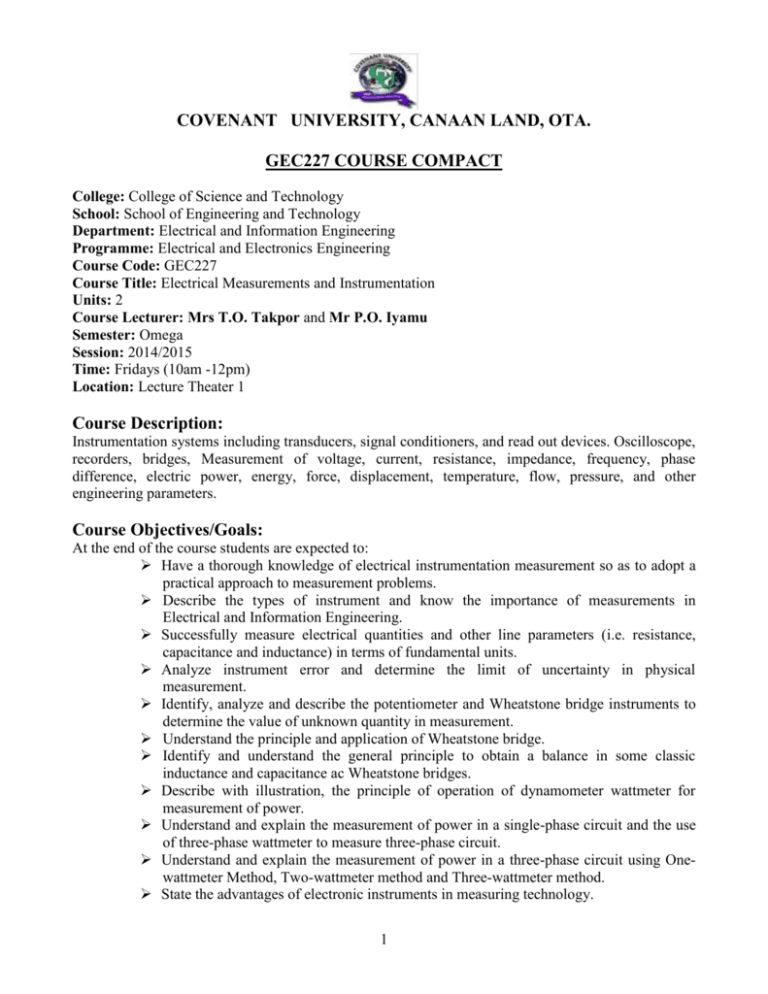
COVENANT UNIVERSITY, CANAAN LAND, OTA. GEC227 COURSE COMPACT College: College of Science and Technology School: School of Engineering and Technology Department: Electrical and Information Engineering Programme: Electrical and Electronics Engineering Course Code: GEC227 Course Title: Electrical Measurements and Instrumentation Units: 2 Course Lecturer: Mrs T.O. Takpor and Mr P.O. Iyamu Semester: Omega Session: 2014/2015 Time: Fridays (10am -12pm) Location: Lecture Theater 1 Course Description: Instrumentation systems including transducers, signal conditioners, and read out devices. Oscilloscope, recorders, bridges, Measurement of voltage, current, resistance, impedance, frequency, phase difference, electric power, energy, force, displacement, temperature, flow, pressure, and other engineering parameters. Course Objectives/Goals: At the end of the course students are expected to: Have a thorough knowledge of electrical instrumentation measurement so as to adopt a practical approach to measurement problems. Describe the types of instrument and know the importance of measurements in Electrical and Information Engineering. Successfully measure electrical quantities and other line parameters (i.e. resistance, capacitance and inductance) in terms of fundamental units. Analyze instrument error and determine the limit of uncertainty in physical measurement. Identify, analyze and describe the potentiometer and Wheatstone bridge instruments to determine the value of unknown quantity in measurement. Understand the principle and application of Wheatstone bridge. Identify and understand the general principle to obtain a balance in some classic inductance and capacitance ac Wheatstone bridges. Describe with illustration, the principle of operation of dynamometer wattmeter for measurement of power. Understand and explain the measurement of power in a single-phase circuit and the use of three-phase wattmeter to measure three-phase circuit. Understand and explain the measurement of power in a three-phase circuit using Onewattmeter Method, Two-wattmeter method and Three-wattmeter method. State the advantages of electronic instruments in measuring technology. 1 Explain the elements of a digital acquisition system in the process of converting analog signal to digital signal. Methods of Lecture Delivery: Lectures will be delivered with the aid of multimedia power point presentation, and static presentation (use of white board and marker). A combination of lectures and tutorials. Course Outline: Module 1 1.0 INTRODUCTION 1.1 Basics of measurements and instrumentation 1.1.1 Error in measurement Week 1 Module 2 2.0 MEASUREMENT OF LINE PARAMETERS 2.1 Measurement of resistance 2.2 Measurement of low resistance 2.2.1 Ammeter/Voltmeter method 2.2.2 Potentiometer method 2.2.3 Kelvin Double Bridge 2.3 Measurement of medium resistance 2.3.1 Ammeter/Voltmeter method 2.3.2 Wheatstone bridge 2.3.2.1 Errors in bridge arms. 2.4 Measurement in high resistance 2.4.1 Modified Wheatstone Bridge 2.4.2 Loss of charge method 2.4.3 The Megger tester 2.5 Sensitivity of galvanometer Week 2-4 Module 3 3.0 AC BRIDGES 3.1 Maxwell bridge 3.2 Desauity bridge (measuring capacitance) 3.3 Wien bridge 3.4 Schering bridge 3.5 Owen bridge 3.6 Heaviside bridge Week 5-6 2 Module 4 4.0 4.1 4.2 4.3 4.4 4.5 4.6 4.7 4.8 4.9 TRANSDUCERS Piezoelectric transducer Linear Variable Differential Transformer (LVDT) Electrical resistance thermometer Thermistors Resistance strain gauge Measurement of speed – Tachometer and digital Tachometer Digital Transducer Telemetry Thermocouple Week 7-8 Module 5 5.0 5.1 5.2 5.3 5.3.1 5.4 5.4.1 5.4.2 5.5 5.5.1 5.5.2 5.5.3 5.5.4 INDICATING INSTRUMENT AND APPLICATIONS Moving Coil devices (Operation Principles, Features & Applications) Moving Iron device (Operation Principles, Features & Applications) Electrodynamics Instruments (Principle, Features and Applications) As Ammeter, as a power factor meter, as moving-iron P.f meter Energy meter and metering. The Dynamometer wattmeter The Induction-Type energy meter Energy Meter - Measurement of power in single-phase circuit Measurement of power in three-phase circuit using one-wattmeter method Measurement of power in three-phase circuit using two-wattmeter method Measurement of power in three-phase circuit using three-wattmeter method Measurement of power in three-phase circuit using three –phase wattmeter Week 8&9 Module 6 6.0 6.1 6.1.1 6.1.2 6.2 6.3 6.3.1 6.3.2 6.4 ELECTRONIC INSTRUMENTATION SYSTEM. Digital instruments Digital techniques measuring systems Application of digital techniques to digital voltmeters (DVMs) Analogue techniques Analogue/digital (A/D) signal processing. Sampling process Analog-to-digital conversion (ADC) Oscilloscope Week 10-12 Tutorials: Tutorials class will be organized at the end of each course module and students are expected to make contribution in solving tutorial questions. Methods of grading: Continuous Assessments; Tests, Assignments and Group Project (30%) Examination (70%) 3 Ground rules and Regulations: Attendance is compulsory; a minimum of 75% class attendance is required. Absolute concentration is required of all students during lectures. Assignments / Group Project: Assignments and Group Project will be given when necessary and students are expected to make contribution during lecture hours. Alignment with Covenant University Vision: A thorough knowledge of electrical measurement and instrumentation system is essential to a practicing engineer. Therefore the inclusion of this course in the undergraduate curriculum of engineering students is important in forming the technical and scientific knowledge of future electrical, computer and communication engineers. This course can be applied to basic measurement techniques, instruments, and methods used in everyday practice. It is valuable to the raising of new generation leaders in electrical, computer and communications engineering fields. Contemporary issues / Industry relevance: Electrical Measurements and Instrumentation is primarily intended to assist the student following an electrical or electronic engineering degree course to adopt a practical approach to his measurement problems. It will also be of use to an industrial engineer, who finds himself involved with measurements in terms of volts, amperes, ohms, watts, etc., and faced with an ever-increasing variety of instruments from a simple pointer instrument to a complex computer-controlled system. The course is aimed at practical conditions and situations. It helps the engineer or instrument user, to select the right form of instrument for an application, and then analyze the performance of the competitive instruments from the various manufacturers in order to obtain the optimum instrument performance for each measurement situation. Recommended Textbooks: Sawhney, A.K., A Course in Electrical and Electronic Measurements and Instrumentation, Dhanpai Rai and Co, Naisarak, Delhi, 2008. Alan Symonds, Electrical Power Equipment and Measurements, MicGraw-Hill Companies (UK), latest edition Gupta, J.B., An Integrated course in Electrical Engineering, 4th edition, S.K. Kataria and Sons, New Delhi, 2010 Salawu, R.I., Principle of Electrical Engineering and Measurements, latest edition. U.A. Bakshi, A.V. Bakshi, K.A. Bakshi, Electrical Measurements, First Edition: 2008 Roman Malaric, Instrumentation and Measurement In Electrical Engineering, 2011 4 5
